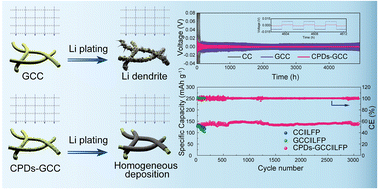The practical implementation of lithium metal remains challenging because of unregulated Li dendrite growth, which results in safety hazards and poor cycling performance. Herein, a stable three-dimensional (3D) hybrid architecture with low voltage hysteresis is fabricated by modifying N,O-codoped carbonized-polymer-dots (CPDs) on a carbon-based substrate (CPDs-GCC). CPDs provide an abundance of lithiophilic nitrogen-containing functional groups and carbonyl groups, which can direct the homogeneous deposition of lithium and reduce the growth of Li dendrites. Moreover, the CPD-based lithiophilic anode reduces the migration energy barrier and activation energy of Li+, enhances the exchange current density, and effectively enhances the ion transport kinetics and ion reaction kinetics at the electrode–electrolyte interface. As a result, the half cells with a capacity of 3 mAh cm−2 allow an ultralow voltage hysteresis of ∼2 mV over 4800 h at 2 mA cm−2. The full cell with a LiFePO4 cathode demonstrates outstanding cycling stability with a capacity retention of 95% after 3000 cycles at 0.2 A g−1. This study examines the factors influencing voltage hysteresis, explores its impact on battery performance, and proposes a simple method to mitigate it. This lays the foundation for the development of high-performance batteries.
